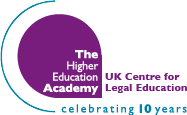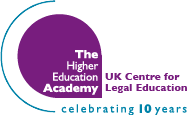Legal skills and multimedia: enhancing student learning
Paul Maharg, University of Strathclyde
How can ICT be used to enhance legal skills learning? What can we learn from the literature on instructional technology and education that will help us to design effective teaching materials for students? Paul’s presentation described the creation of multi-media resources for a legal skills course, drawing general conclusions about the design of such resources, their use with students and how aspects of research on instructional technology can be used to predict the success of resource-based learning initiatives.
At Glasgow Graduate School of Law (GGSL) 180 students on the Diploma in Legal Practice, together with 30 tutors, use a set of multi-media resources on a two week foundation course in legal skills. The resources are made available to students and tutors from an intranet and also on CD-ROM, and are embedded within the workshops of the foundation course.
A period of eight months was set for the development of the resources. The costs of the project in terms of time were 200 hours, excluding programming, video shoot and editing time. The initial staff start-up time was high, but in terms of money the development costs were very low, as visiting professors were used as actors. However, it was a stressful process, particularly towards the end – never underestimate the time it all takes…
The Diploma curriculum strategy includes skills days for interviewing and negotiation and mediation skills. The foundation course is centred around GGSL’s virtual community, where the Diploma students take on the role of law firms, each with a customisable website. IT training is provided for the students plus ECDL training for tutors.
Multi-media resources were developed for three projects within the virtual community:
- personal injury project: half the firms represent an injured employee, the other half the insurer’s legal agents
- private client project: winding up a deceased client’s intestate estate
- legal research project: each student writes two articles (500-700 words) updating the law in a specified area of law for clients. The best articles are awarded prizes and feature in the virtual community’s library
The first steps in the creation of the multi-media resources were to define the over-arching narrative structure of resources and to scaffold the structure and shape of each unit. Five authors were involved in this process, which took two months, based on 10 hours work per week.
Skills outcomes in the lectures and workshops were the focus of the course materials. In producing the text for the resources versions of text drafts were produced and altered according to screen appearance. The display method on the screen went through seven iterations. For video production, the authors/actors had outline scripts only – the real script was the learning outcomes. Video content was chunked and tagged during video-editing – this task took four months, based on around six hours per week.The overall re-drafting process, which took three weeks (based on five hours per week) consisted of three stages:
- ensuring smooth text links between video and text samples and explanatory text
- achieving a uniform and neutral register of voice
- proofreading
Finally, 220 CDs were burned, labels and covers designed and produced, which took one week of full time work.
Future developments include:
- revision and extension of the resource scenarios
- creation of interactive video projects in the Diploma curriculum
- extension of the virtual community resources
- an increased focus on interpersonal skills elements in the virtual firms
Lessons learned:
Don’t:
- use IT unless there’s a perceived need for it
- develop develop multi-media resources as an isolated strategy
- define benefits in terms of costs alone
- design without planning
- plan without student & staff training
- underestimate time, cost, energy, re-drafting
Do:
- keep the development plan as flexible as possible
- centre IT learning around social learning activities
- integrate learning technology as low as possible in learning and teaching interventions
- try to anticipate the operational (day to day) as well as the policy and strategic needs
- make the resources part of the culture of your learning and teaching strategy
- use the resources as an agent of change as well as part of the change strategy
- share your vision and objectives – with everyone who’ll listen!
Last Modified: 12 July 2010



Comments
There are no comments at this time